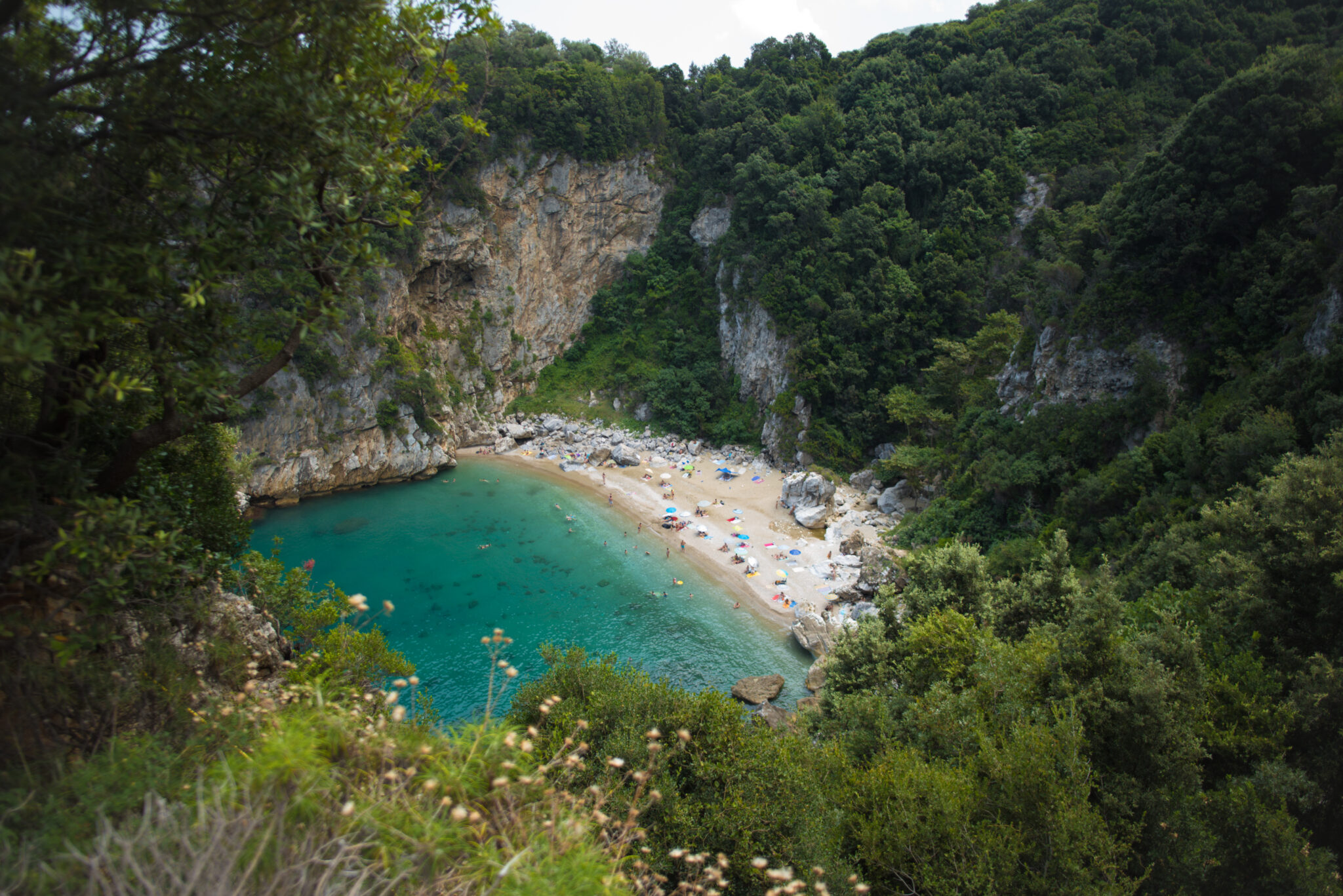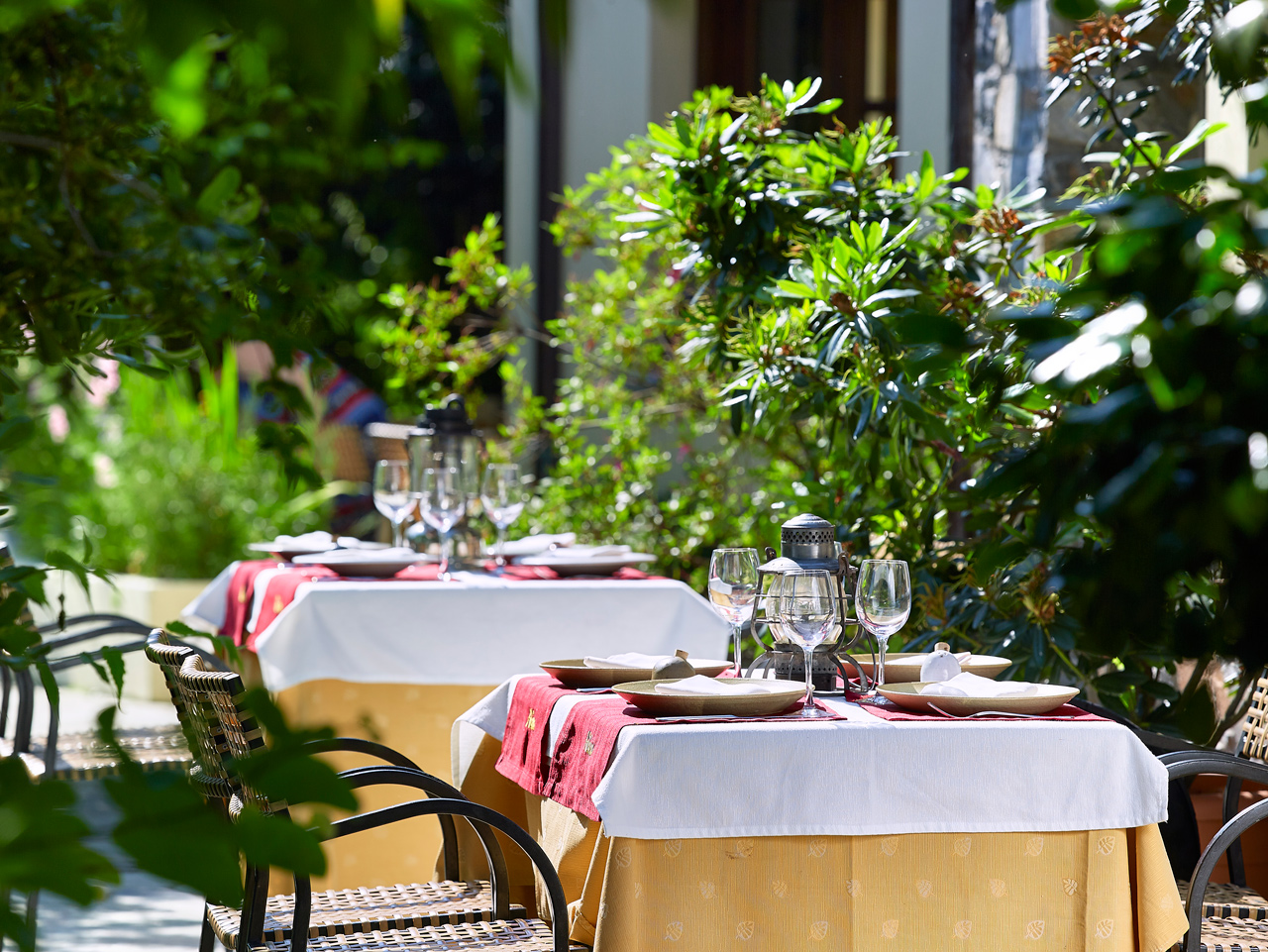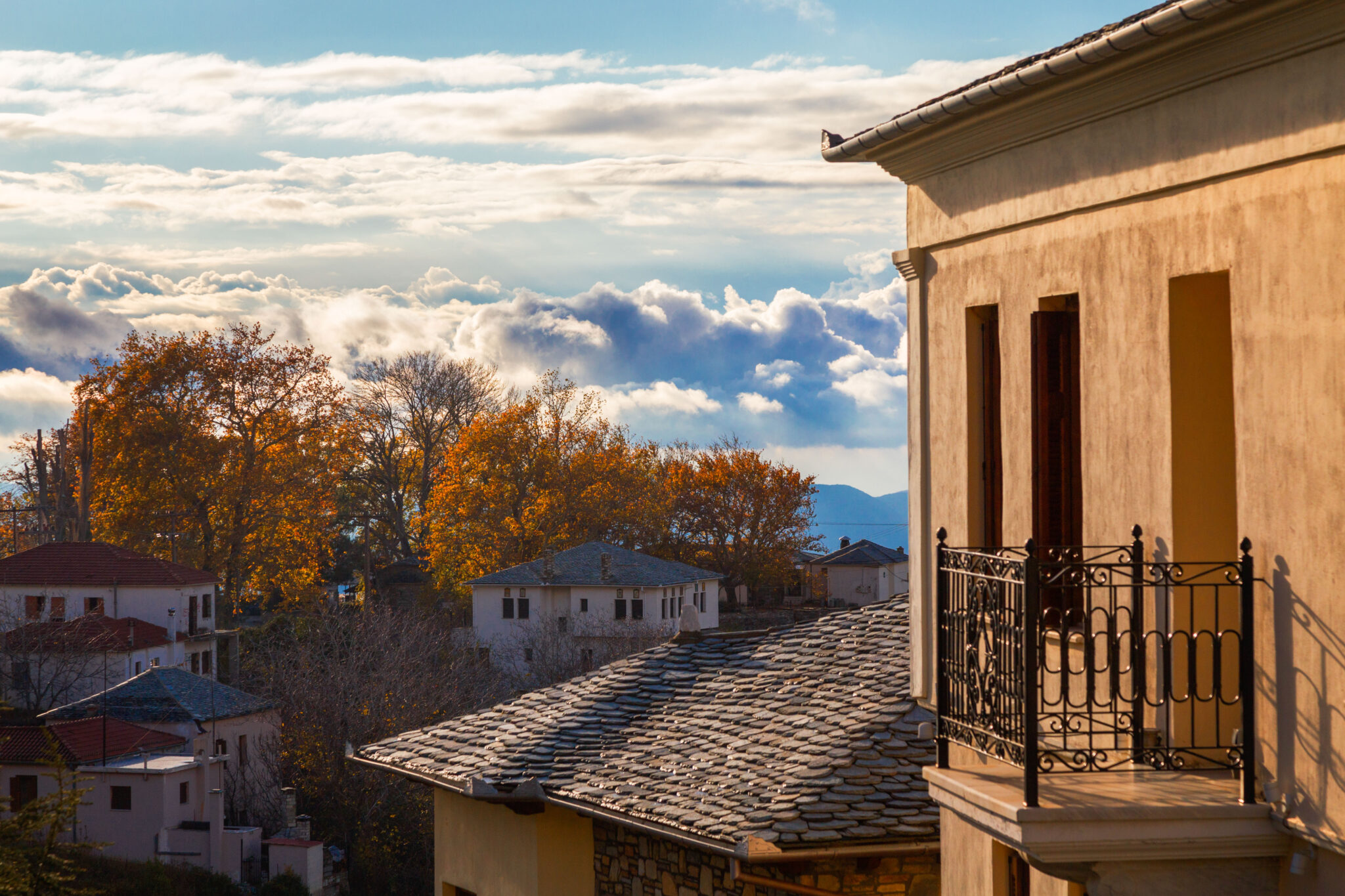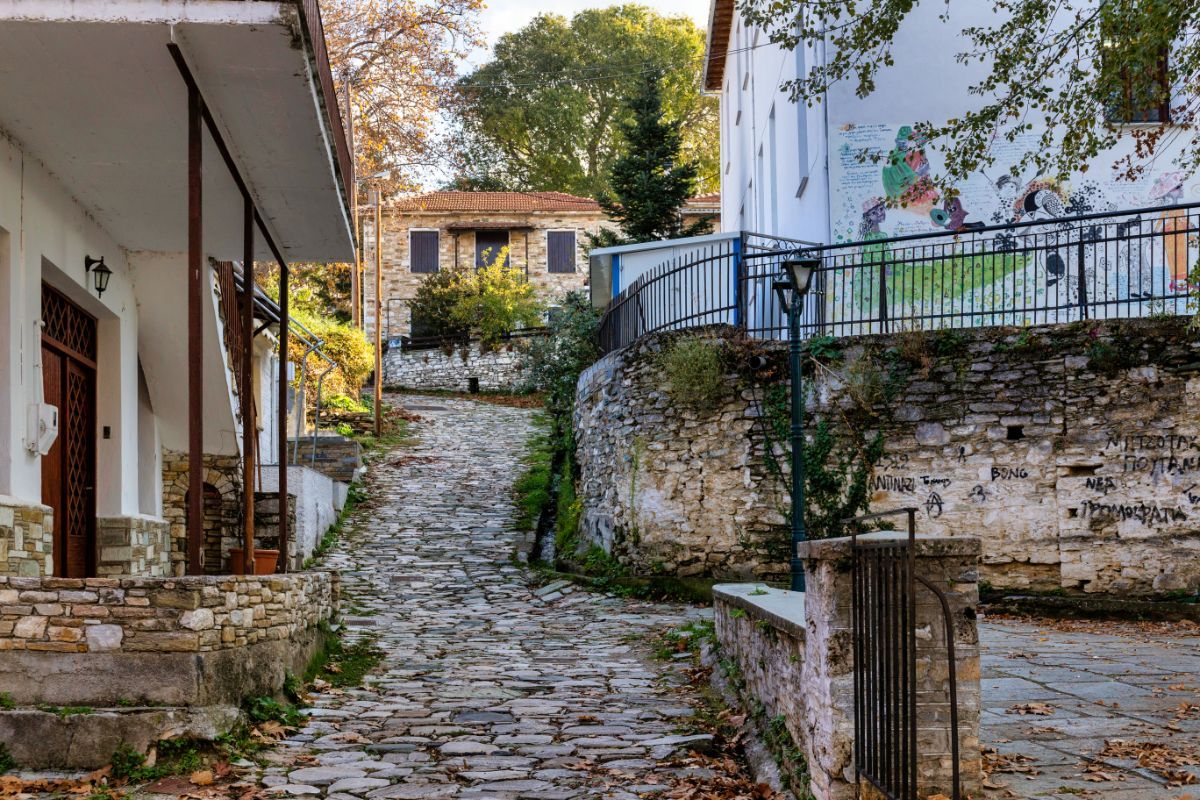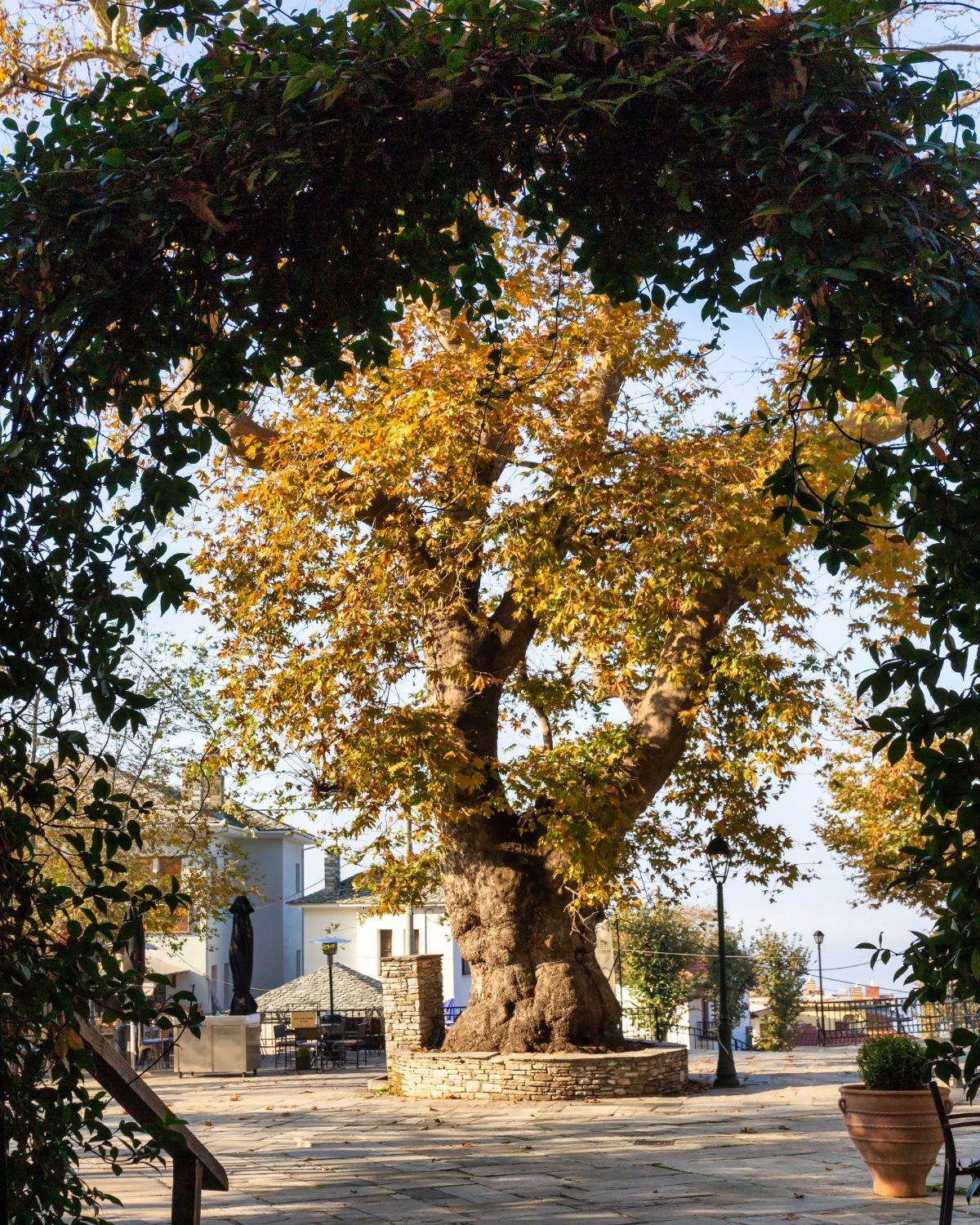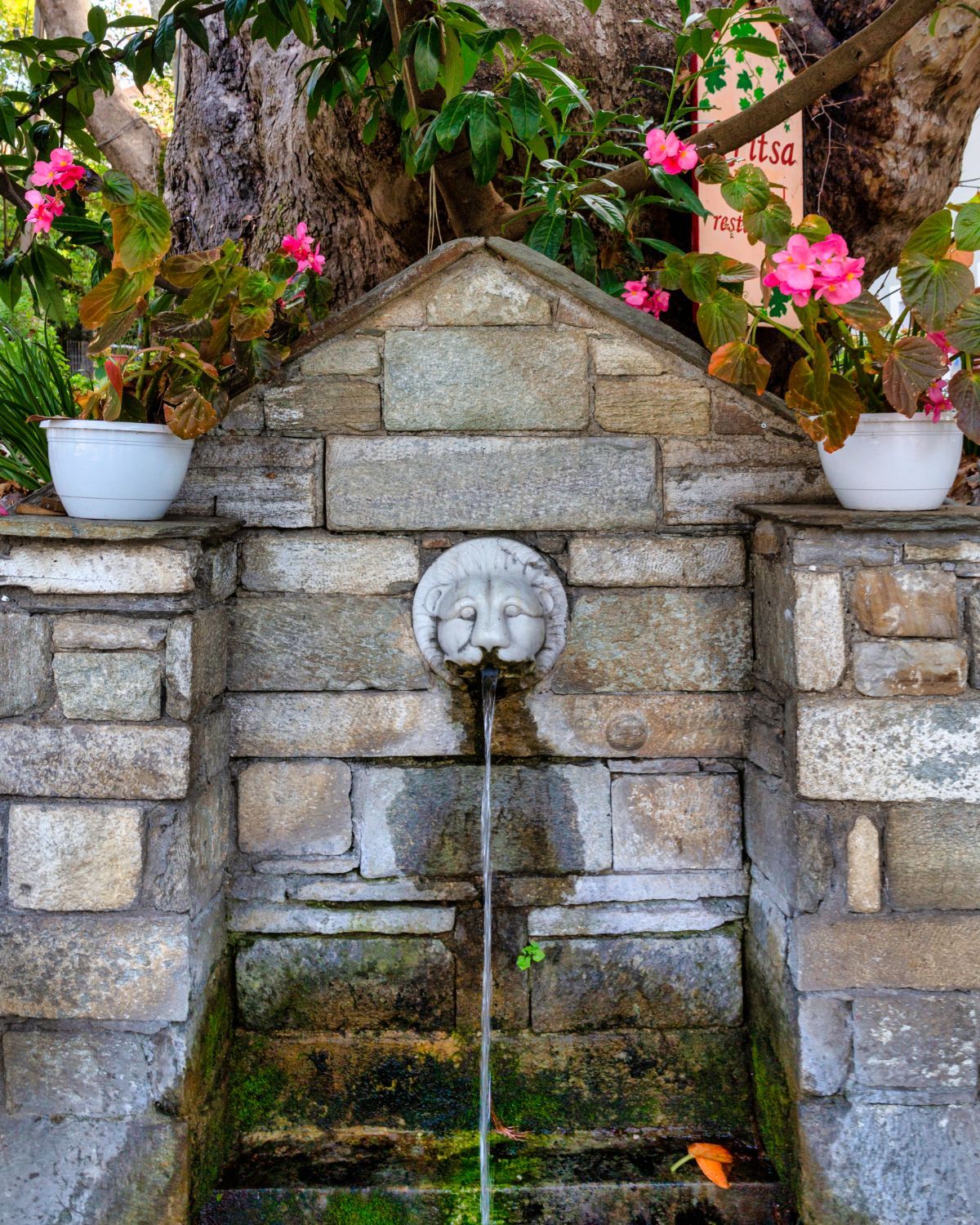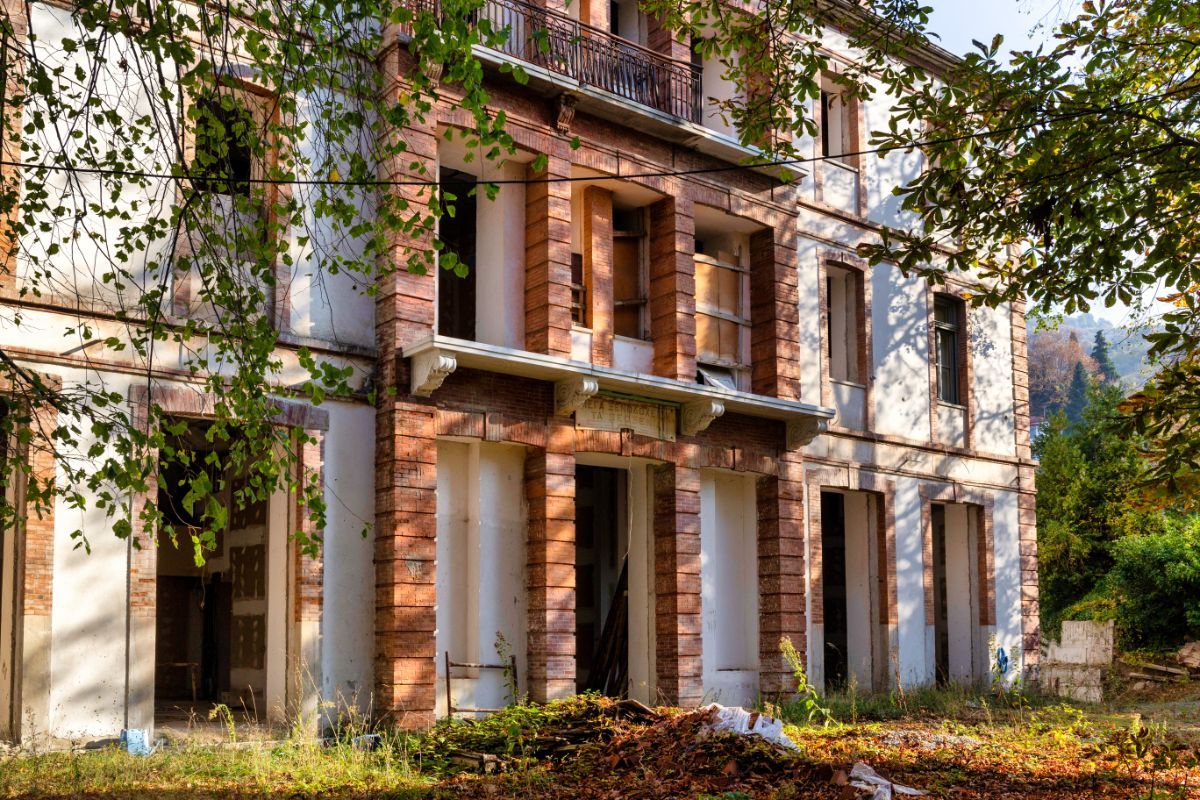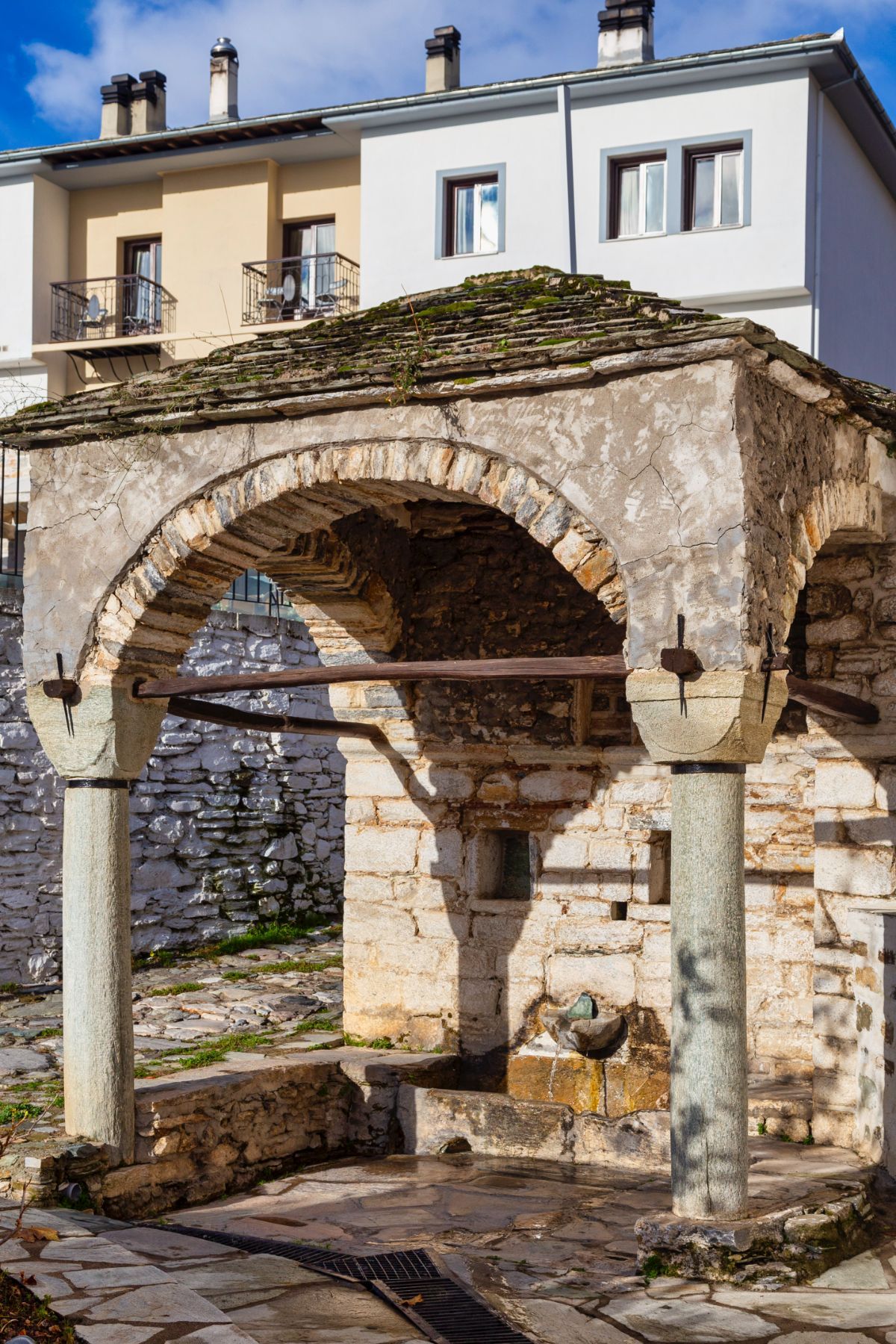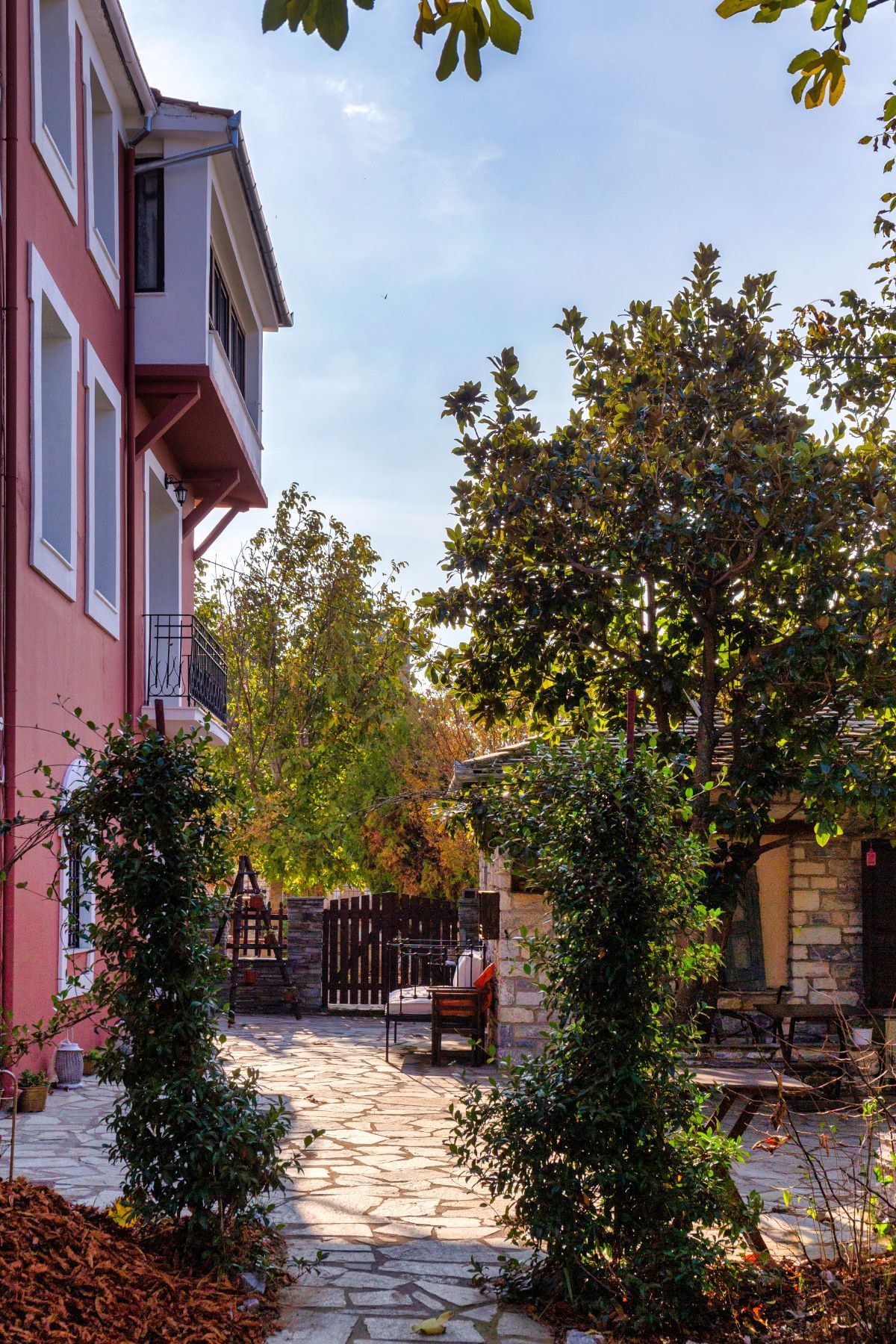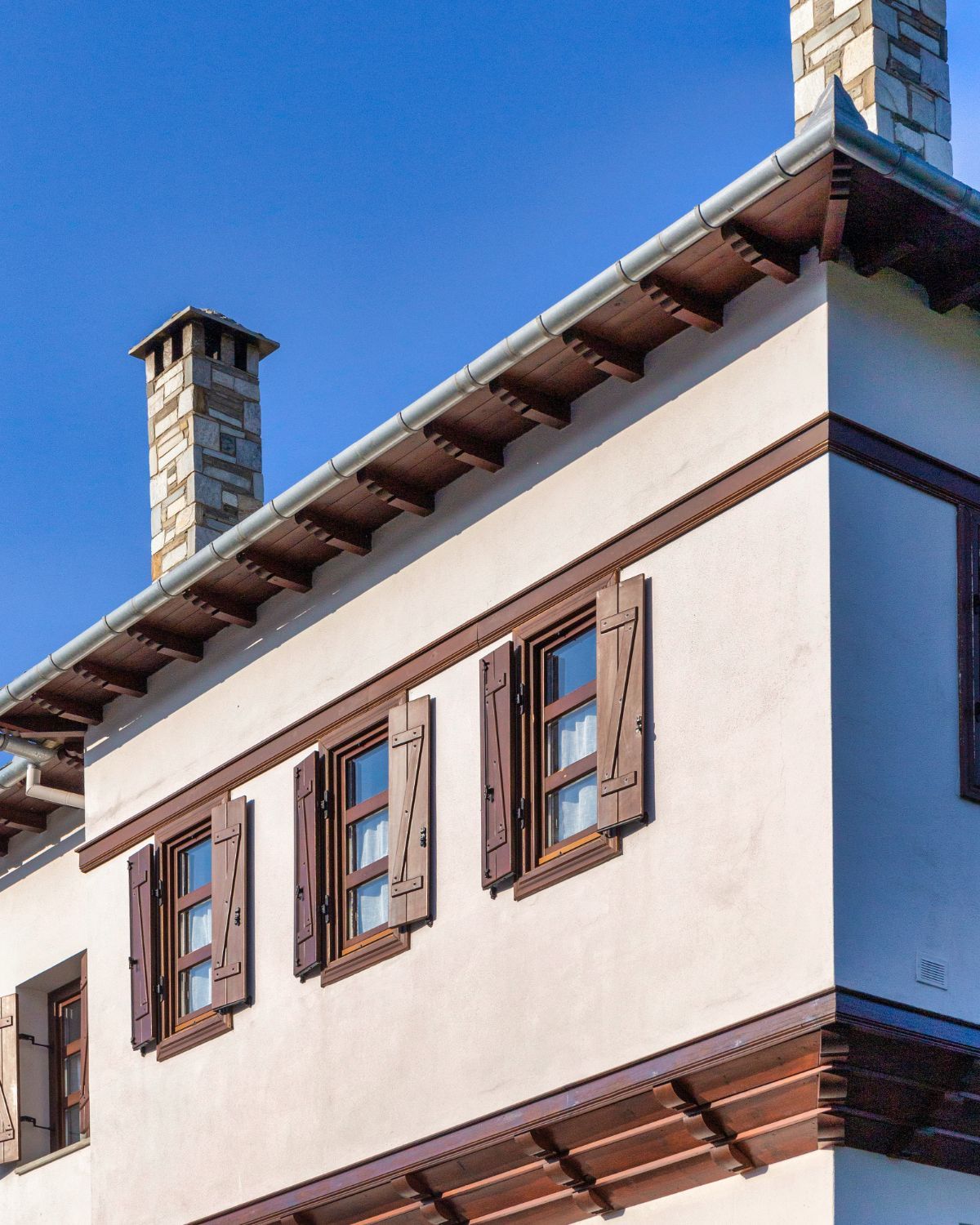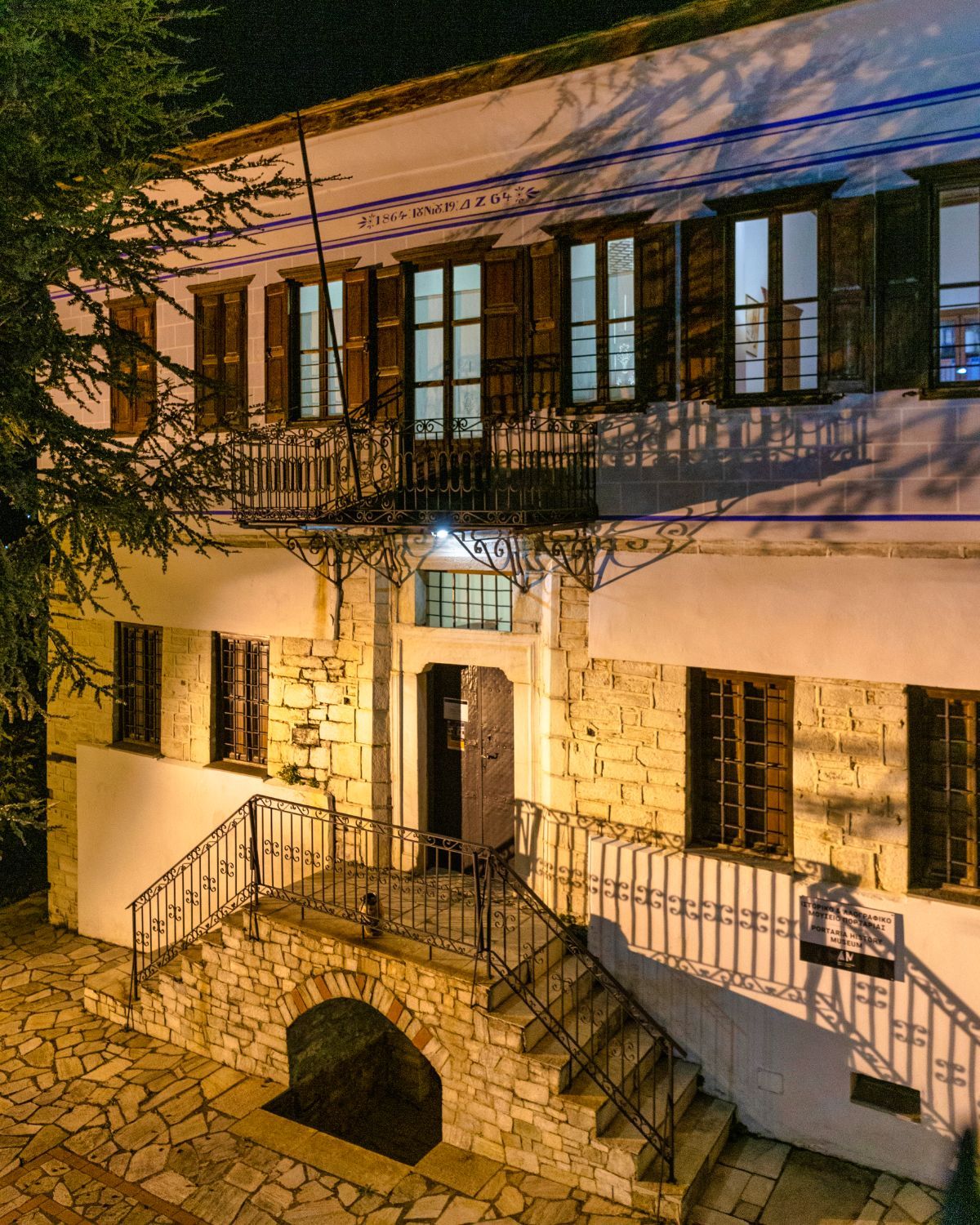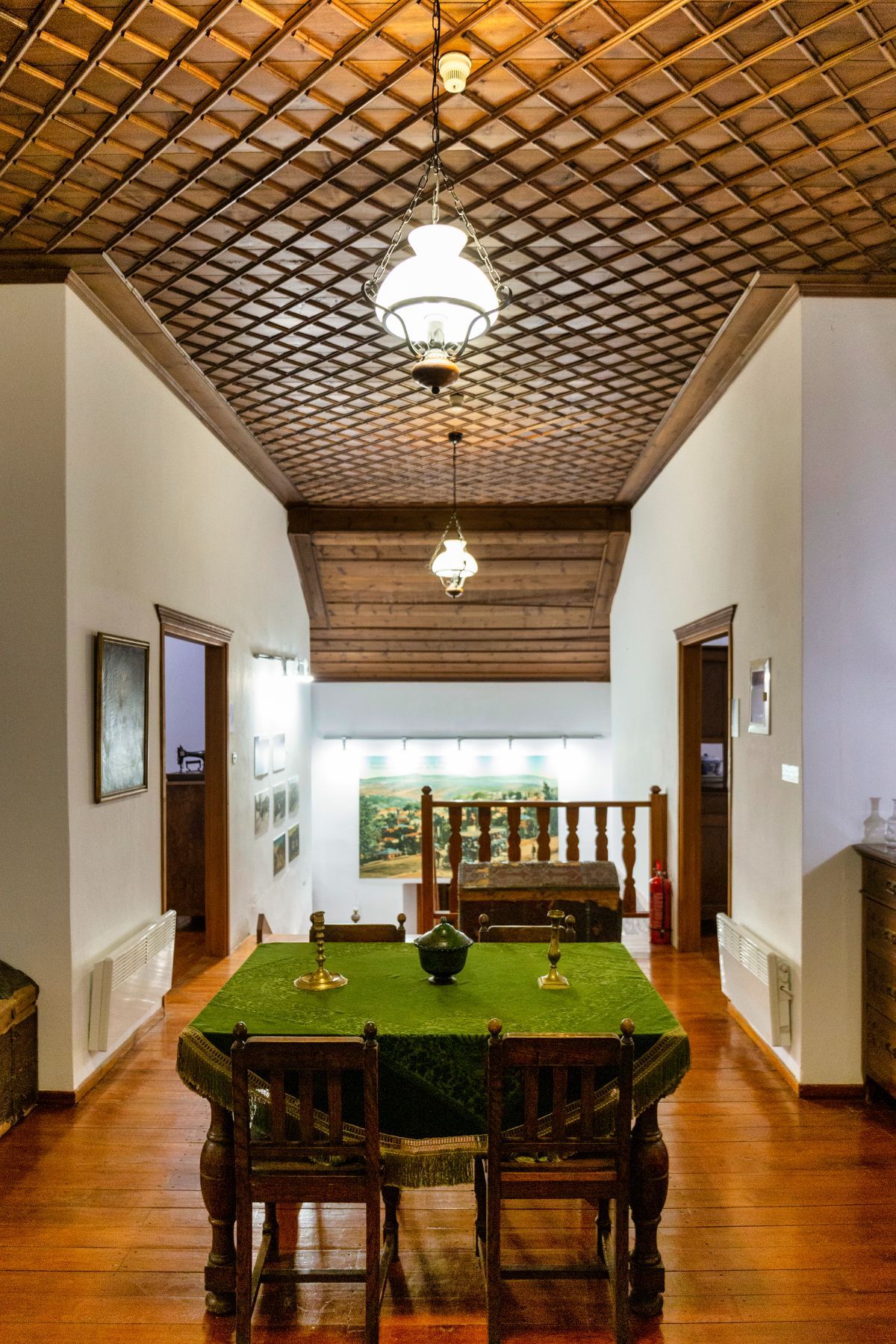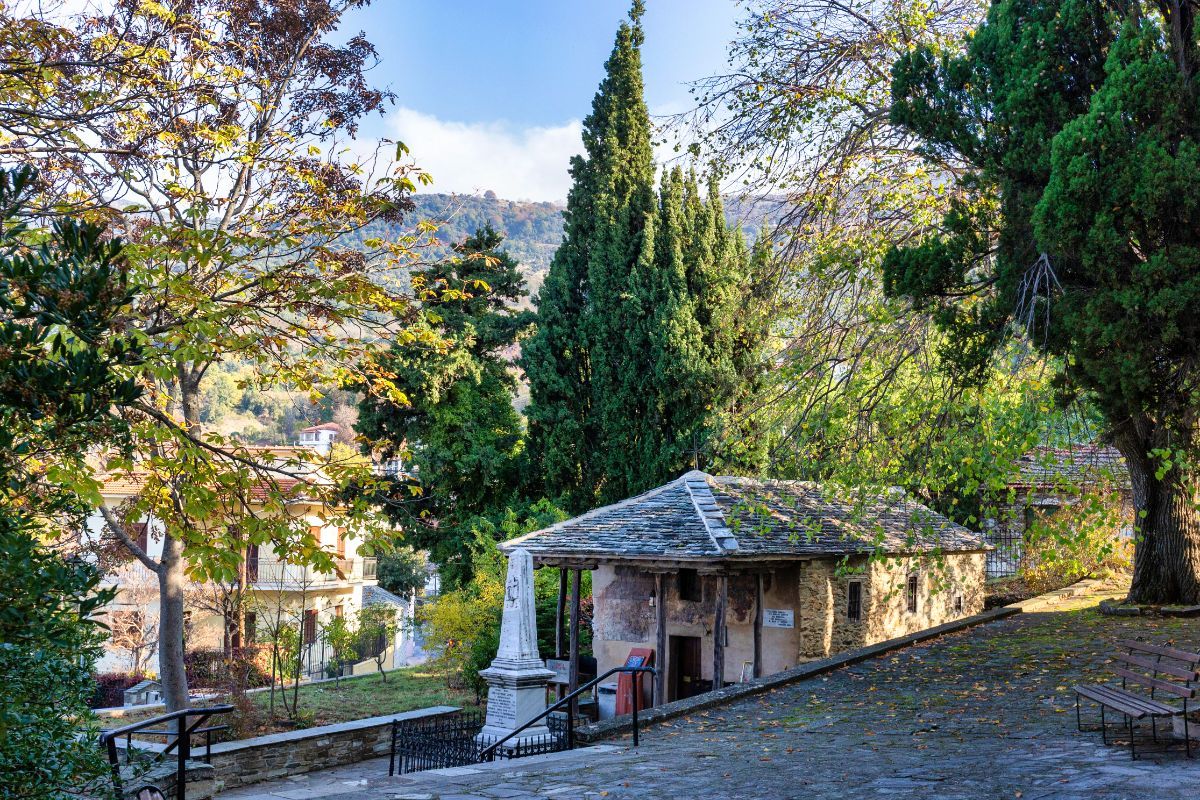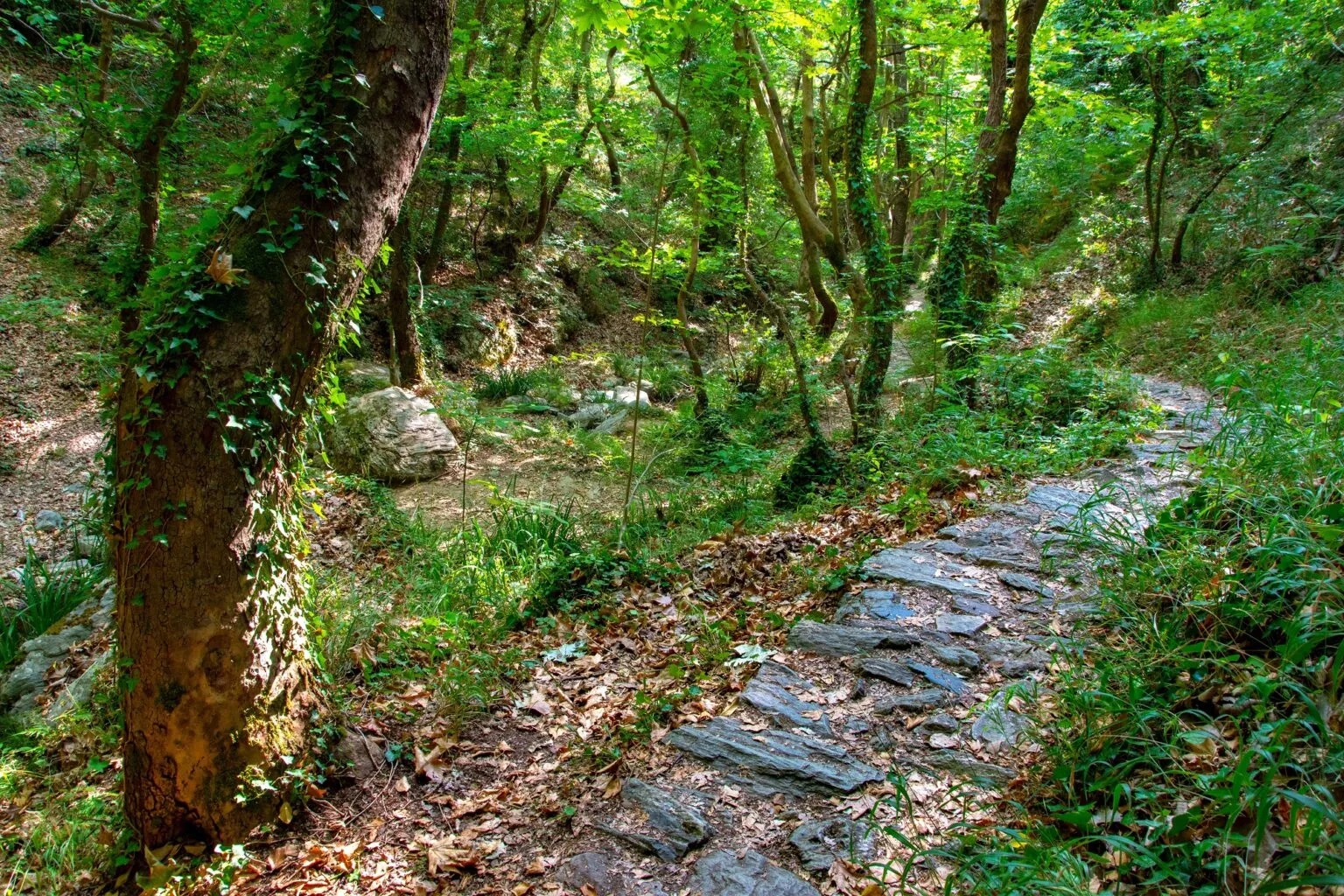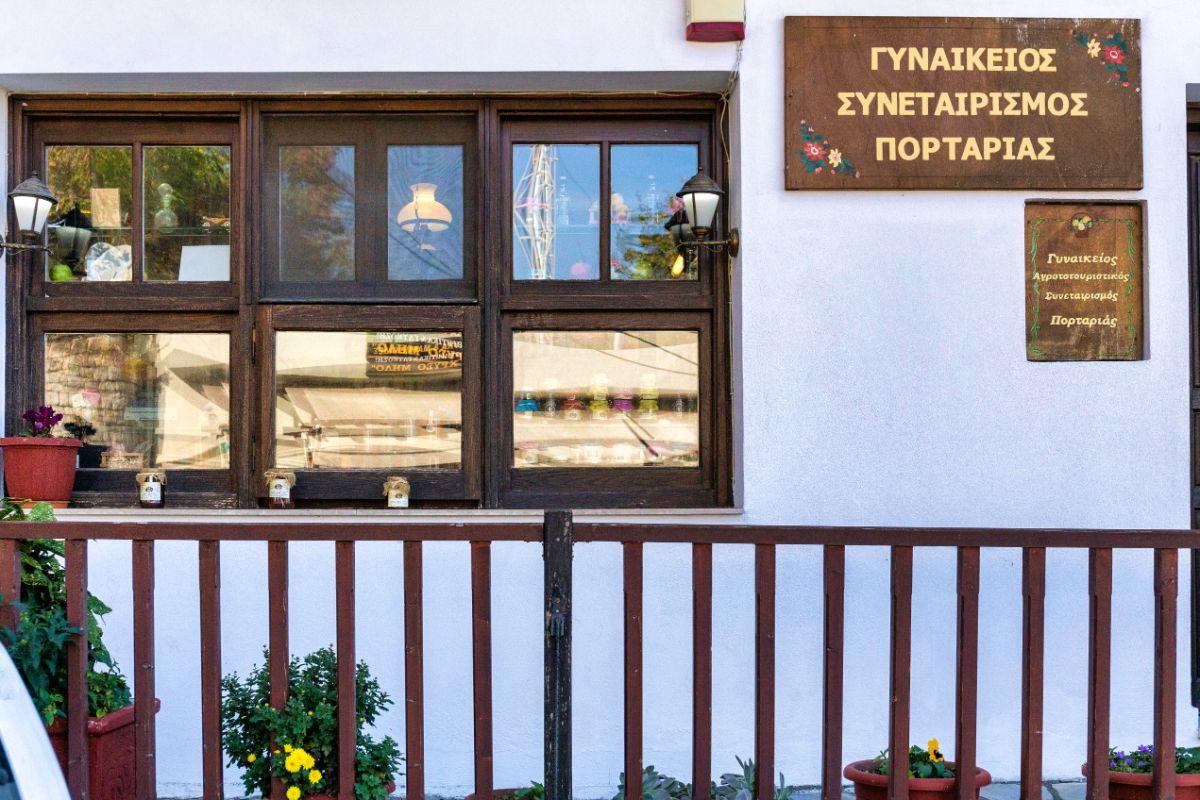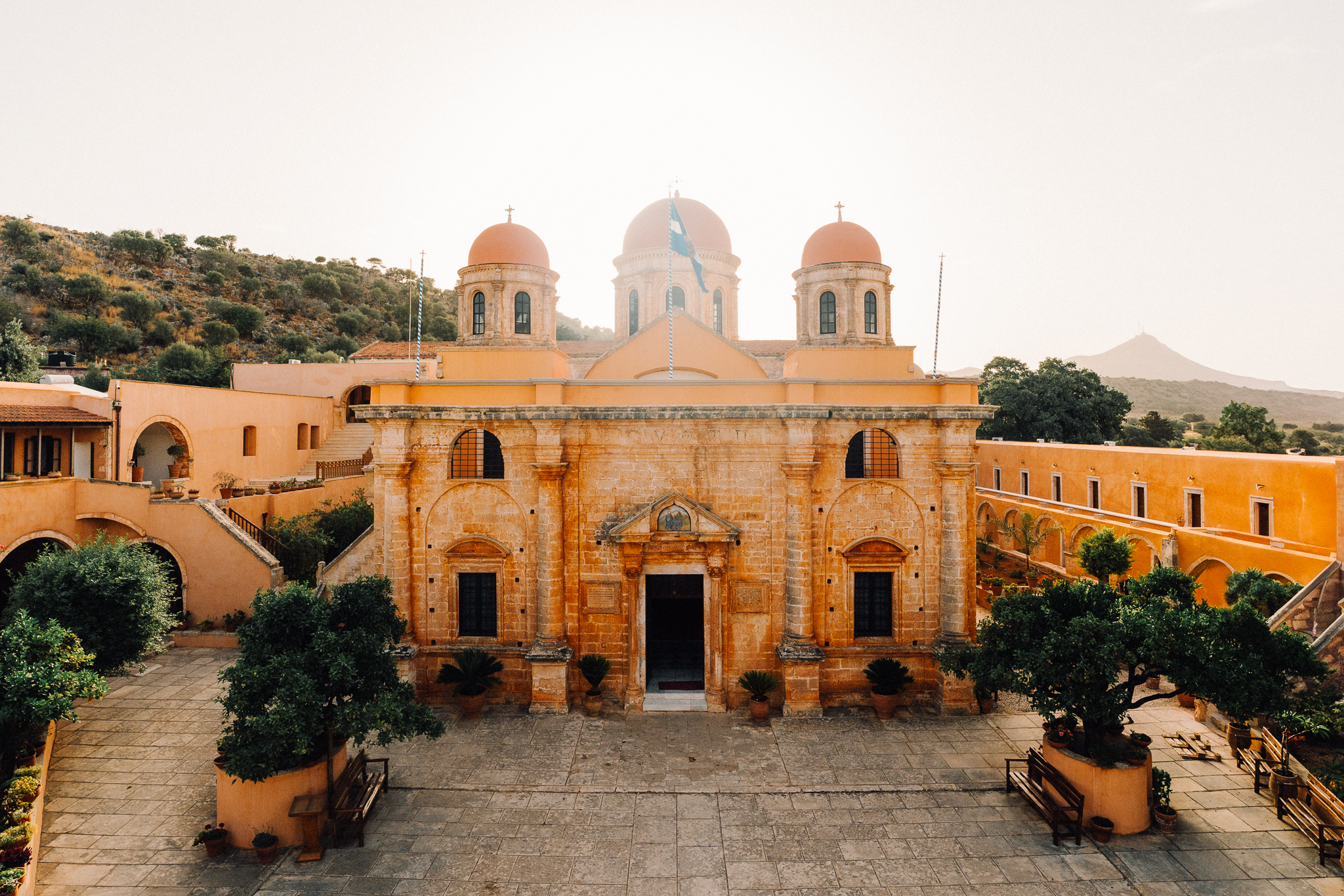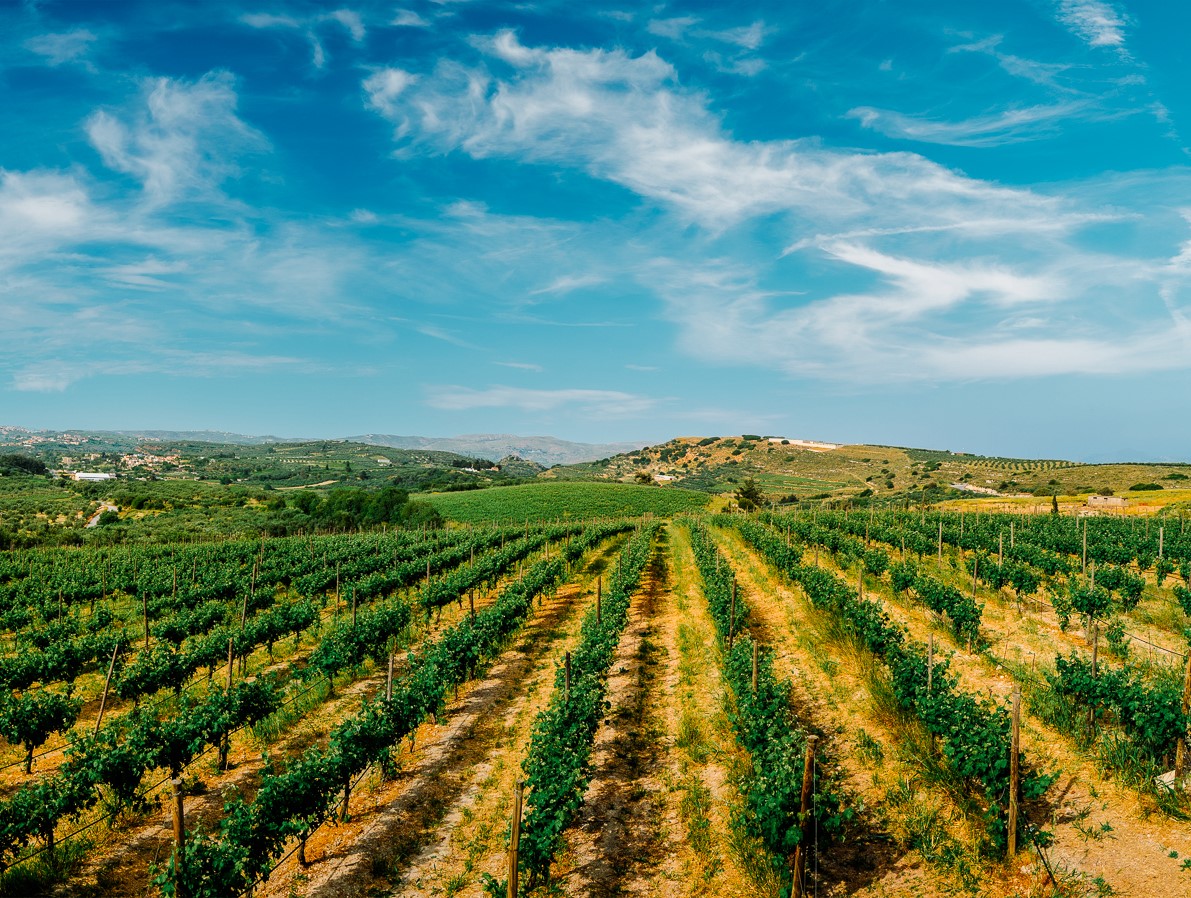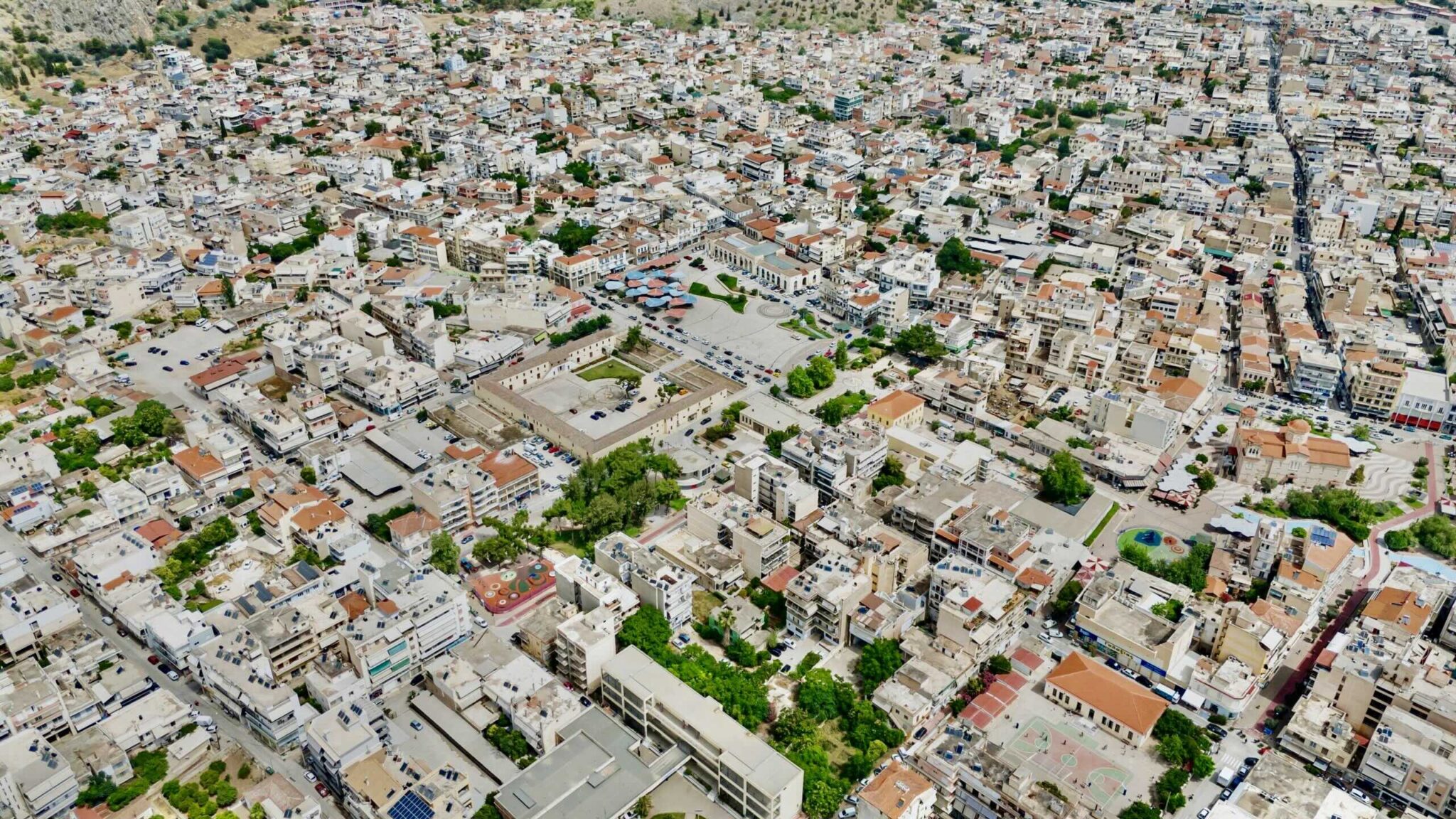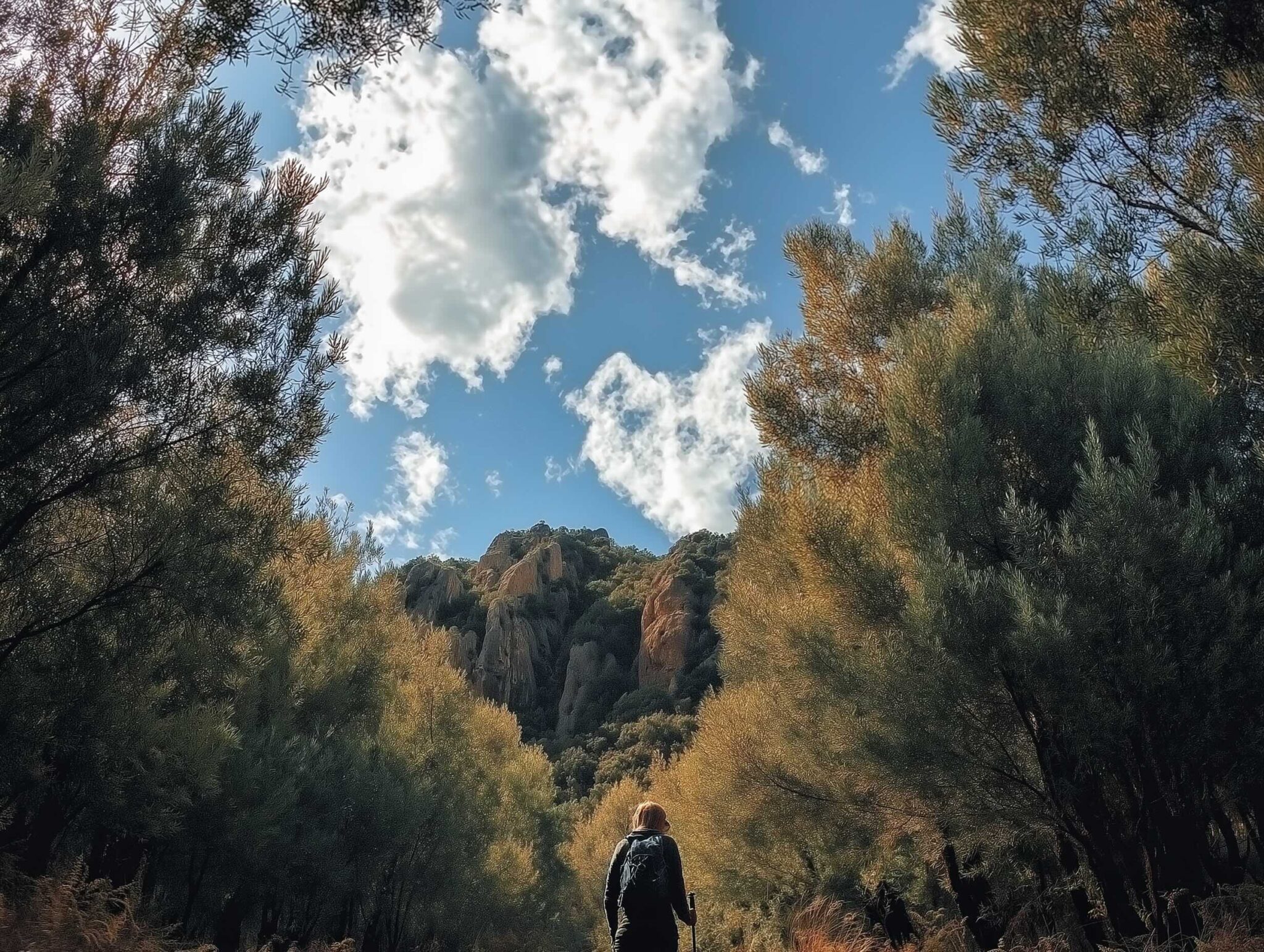There is a theory that the name Portaria comes from the Greek word ‘porta’ (Πόρτα) meaning door, and refers to the village’s position as a ‘gateway’ to the Pelion mountain. Another, perhaps more solid theory, is that it was named after the Byzantine monastery of Panagia Portarea, founded in the 13th century, a small church of which still remains within the courtyard of the church of Agios Nikolaos. Portaria lies on the Western slope of Pelion in the Magnesia region of Thessaly, just 12 kilometres (7.5 miles) from the port city of Volos, where ferries keep the mainland connected to the islands of the Sporades (Skiathos, Skopelos, Alonissos).
This traditional village is worth a visit for its stunning location, amazing architecture, and unique history. The region can change dramatically with the seasons. In Summer, it is hot and dry. In Autumn, the area is draped in shades of yellow, red and brown, when Portaria goes through a time of relative calm. Then the “storm” of Winter brings an influx of holidaymakers who crowd the village due to its proximity to the Agriolefkes ski resort.
From the main square to the stone cobbled alleys with the restored mansions The uphill street, passes in front of the old Town Hall, and leads to the main square. Along the way, you are accompanied by the sound of running water coming from the numerous stone founts. In Spring, The square, with its restaurants and amazing views, is vibrant with activity. And in the Autumn it is covered in leaves that have fallen from the tall plane trees which have stood in the square for centuries. They are surrounded by hydrangeas and camellias.
The contrast between one side of the square, bustling with life, and the other, with a vast garden and an abandoned building in ruins, is striking. The garden and building belong to the “Mega Theoxenia” hotel, which was one of the most luxurious hotels in the Balkans in the early part of the 20th century. It was built in 1908 by the Athanasaki family, local benefactors, whose Volos residence is now home to the Athanasakio Archaeological Museum of Volos.
Like many other residents of Portaria, the Athanasaki family belonged to the “Egyptiots”, a Greek community living in Egypt. Portaria expats lived and thrived in Egypt, and returned to their grand homes in Portaria in the Summer. They brought with them a number of important guests, which is why this luxury hotel is here. Unfortunately, during the Second World War, the glamourous history of the hotel came to an abrupt end. In 1944, it was burned by the Germans.
Following the main road, or the dozens of cobbled alleyways, to the sound of the cool streams, you can discover many remarkable mansions overlooking the Pagasetic Gulf and the city of Volos. Many of the mansions have been turned into guesthouses and luxury boutique hotels. You’ll notice that there are two different styles of architecture dominant in the village.
The Egyptiot houses have double exterior staircases leading to a first floor entrance and usually have a balcony on the first floor. While the typical Pelion houses have the entrance on the ground floor, in the garden, and don’t have balconies. Typical examples of the Egyptiot style are the old Town Hall, the Tsaxiri Mansion, and the Zoulia Mansion, that today houses the Historical and Folklore Museum. Right behind this is the amazing Kantartzi Mansion that until recently operated as a hotel.
Historical and cultural highlights
To get better acquainted with Portaria’s history and learn about its people, the Historical and Folklore Museum is a must. The museum’s collection is divided in thematic sections and includes family heirlooms and family photographs. During your visit you will be able to explore an authentic Egyptiot mansion. The country house of a great benefactor of Portaria, Dimos Zoulias was built in 1864. Zoulias made his fortune in the cotton trade in Egypt.
The museum will take you on a trip back to the time when Portaria, and the nearby village of Makrinitsa, were jointly name Ano Drianouvena, a name that seems to refer to the thick woods in the area. The name was used as recently as the late 13th century. Here, you’ll learn about the two periods of local prosperity: the first took place during the Ottoman rule, when the Turks seized many houses in Volos resulting in many people from Volos moving to Portaria.
Since a large part of the village was owned by Ottoman officers, in plots of land called ‘hasia’, the area enjoyed a certain number of privileges. This is the period when handiwork, the growing of silkworms and the art of weaving exquisite silk scarves developed. The second wave of prosperity came when people from Portaria travelled to Egypt where they became successful merchants, trading cotton, and bringing riches and fame back to their homeland. These people were able to fund important infrastructure, build educational institutions and contribute greatly to the cultural growth of Portaria.
The museum also tells the stories of the ‘ordinary’ people of Portaria, through exhibitions of old furniture, homeware, and clothing. There is a hall dedicated to the Mega Theoxenia hotel, where the hotel’s valuable china sets can be found, together with photographs of the hotel and its guests, bringing the time when Portaria began its time as a famed holiday destination back to life.
North of the main square, the road goes uphill leading to the largest of the village’s beautiful churches, the church of Agios Nikolaos. It’s a typical three-aisled basilica built in 1885, with a tall bell tower, an impressive ornate iconostasis (painting of religious icons), and a courtyard covered in hydrangeas. There is a monument dedicated to the fallen of the First World War, those who lost their life fighting in the Albanian front and those who were executed in the Second World War the courtyard. Near the bell tower, is a tiny, charming church, Panagia Portarea, the religious centre of Portaria, with a beautiful fresco over the entrance, and 16th century interior decorations.
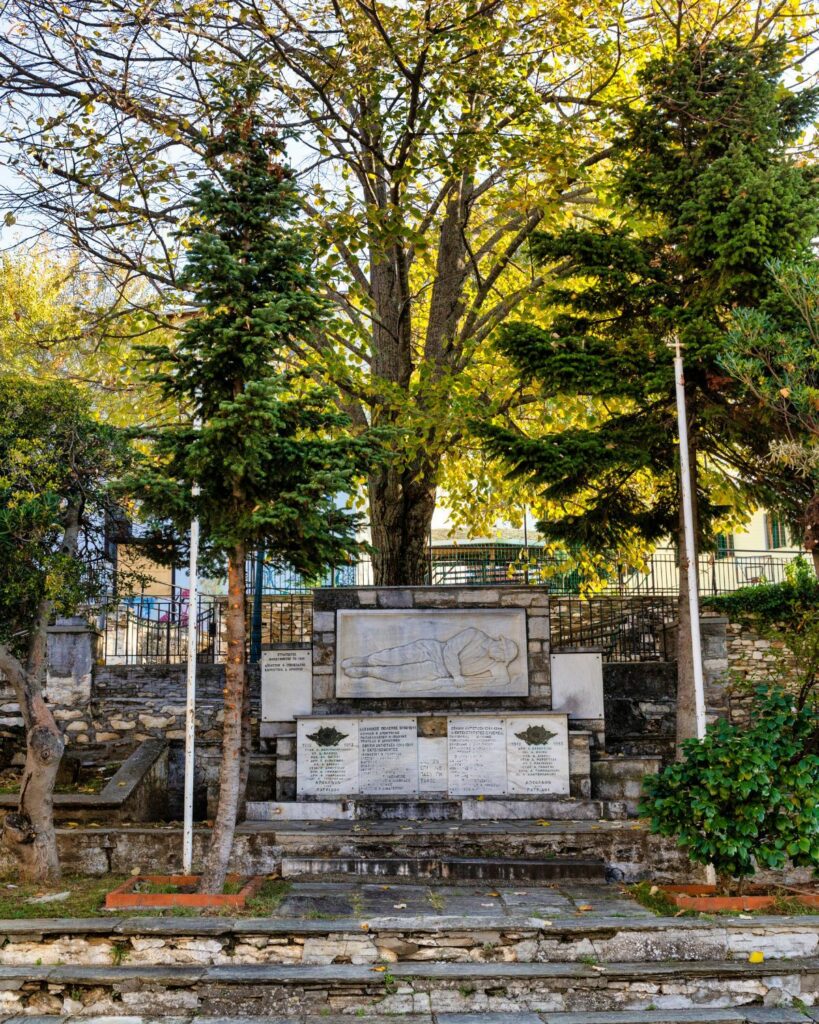
Leaving the church, go across the street to the small Aderfosini square to admire the view, or follow the winding path between the beautiful mansions and the traditional village houses. This leads first to the chapel of Agios Georgios and then to the church of Agioi Anargiri where you will find an amazing panoramic view of the city of Volos.
In search of the Centaurs
The myth of the Centaurs is forever associated with Pelion. These half-human half-horse creatures were said to live in the mountain. The most famous among them, Chiron, is said to have been Hercules’ and Jason’s teacher, an expert in the martial arts, art, and science. Real people, healers of the time, would cure the locals using herbs they collected in Pelion, and they were imagined as half-human half-horse in form due to travelling from one village to the next on their horses.
The Centaurs Path is one of the easiest hiking trails in Pelion. According to legend, the trail was used by the Centaurs to reach east Pelion. As soon as you cross the Adamena gate – the entrance to the path – you’ll be welcomed by nature of unique beauty. The path leads from Portaria to the Mana spring that provides water to the village. It travels uphill and is surrounded by tall plane trees, covered in ivy, and surrounded by ferns. The gurgling of the many springs and streams along the way is constant, and the seven small wooden bridges you’ll come across add to the path’s charm. On your way back, make sure to stop at the turn of the main road and take in the view, reaching all the way to Makrinitsa.
Where to stay
Portaria is once more the popular, welcoming destination it was in the past. Many of the village’s impressive mansions have been restored with care and turned into high end accommodation. Two great options on the main square are the hotels Filoxenia and Kritsa Gastronomy. The first is the oldest hotel in the village, in operation since 1939. It has warm, inviting rooms with thick rugs, and serves delicious homemade breakfasts comprising of pies and various desserts. The walnut pie and the ravani are highly recommended. Kritsa Gastronomy Hotel, partly responsible for putting Portaria on Pelion’s gastronomy map, offers an amazing and rich breakfast not exclusively for guests staying with them. They have what is perhaps the best cheese pie in Pelion, various desserts, marmalades made with local fruit, fresh rice pudding and authentic local recipes such as fried eggs with wild greens, all served with local herbal teas.
At Archontiko Pantou, a renovated 20th century guesthouse, you can enjoy the view of Volos and the Pagasetic Gulf and stay in lovely rooms with wooden ceilings with exposed beams. In the Egyptiot Naoumidis Mansion, history meets luxury and romanticism. Some rooms have their own fireplace, as do the stone suites with the wooden ceilings and jacuzzis. Depending on the season, breakfast is served either by the fireplace or in the garden. In the summer the pool is perfect for cooling off. Another historic building, in the centre of the village since 1884, has been turned into the The Lotus Tree hotel, with great views, offering suites and family rooms. There is a spa and hammam (Turkish bath) where you can order various massage treatments.
Where to eat
Kritsa Gastronomy Hotel is the perfect choice for great food in a welcoming, friendly atmosphere, serving traditional Pelion dishes in Pelion. The fried eggs with wild greens are a local essential. On a cold night, the trachanas (traditional pasta made with flour and yoghurt) with crumbled feta and smoked paprika is a must. You’ll taste great flavours at Gefsokratoras, hhidden from the world on a narrow, scenic, uphill cobbled alley. An open fire spreads warmth throughout the elegant room. Its creative cuisine leaves nothing to chance, from the homemade plaited bread and the light tiganopsomo (fried bread) stuffed with cheese, to the classic caramelised mushrooms and the pork shank, the food at Gefsokratoras is always a special experience.
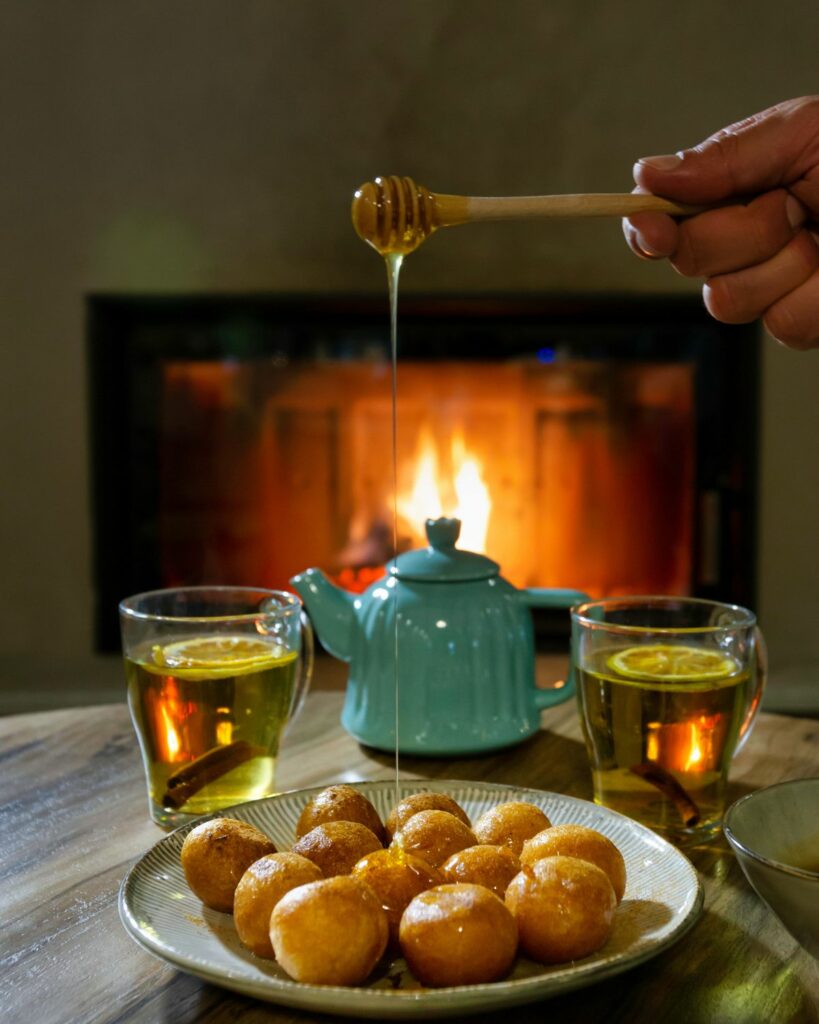
Another warm, welcoming eatery with a fireplace is Agora 1955, an elegant all day café-bistrot that is also a wine bar and delicatessen. Come here for a piece of tasty breakfast pie and cappuccino, a light snack and fresh salads for lunch, or for the delightful bite-sized loukoumades (traditional fried dough balls served usually with honey and walnuts). In the evening, select one of the wines from the Thessaly vineyards and pick a snack to go with it, like fresh anthotiro cheese with honey, or bruschetta with galotiri cheese, village sausage and cherry tomatoes. You can also purchase traditional local goods, like honey, marmalade, spoon sweets, homemade pasta, dried mushrooms, soaps and other cosmetic products.
The shop at the Women’s Agricultural Association of Portaria celebrates 25 years of operation this year. You can buy homemade sweets made with local fruit, local honey, oregano, pickles, homemade tomato sauce, hilopites (a type of pasta), various liquors and Karazafeiri Estate wines, from the vineyards of Katihori. The women of Portaria also make delicious baklava, traditionally served at weddings.
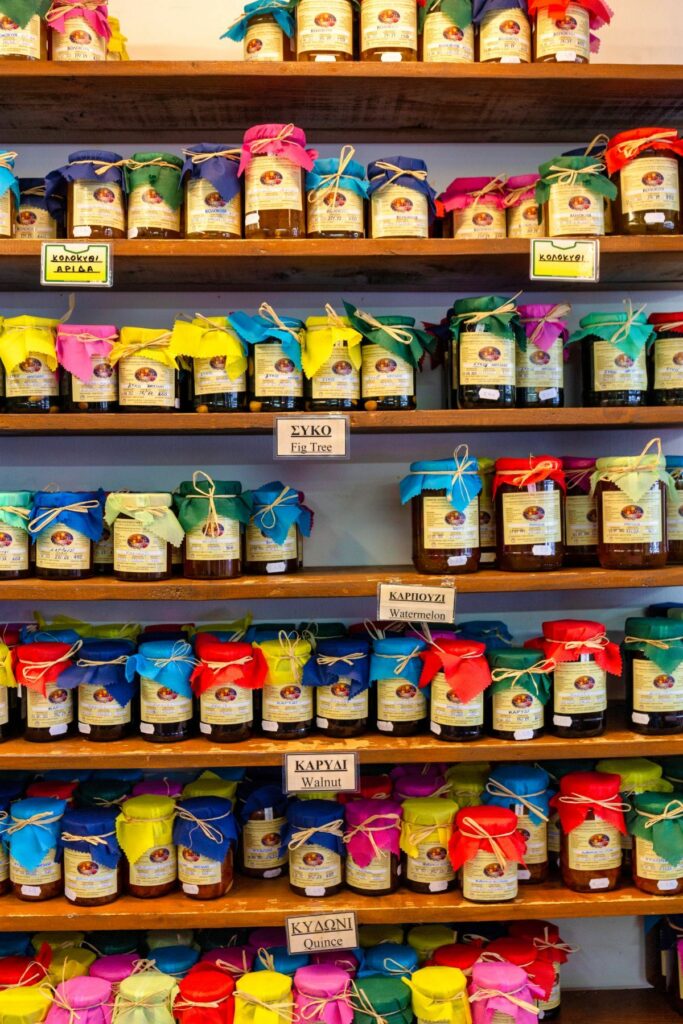
It is definitely worth visiting the Herb Centre shop to choose from an incredibly wide range of herbs and spices and special therapeutic herbal tea mixes, as well as from a variety of tea-making accessories. These small, tasty buys will remind you of this beautiful Pelion village until your next visit.
Read also:
Enjoy one of the most beautiful train rides in Europe in this quaint Greek village
The quiet mountain village of Greece with the amazing view – Great strolls, traditional food
Christmas in one of the most beautiful mountainous destinations of eastern Greece



